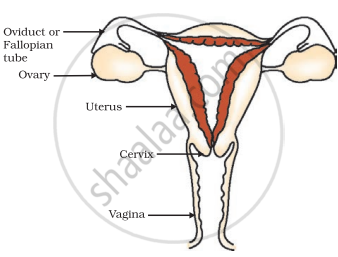Advertisements
Advertisements
प्रश्न
Explain how the embryo gets nourishment inside the mother’s body.
State, in brief, how an embryo gets its nourishment inside the mother's body.
Explain how the developing embryo gets nourishment inside the mother's body.
उत्तर १
After implantation, a disc-like special tissue called placenta develops between the uterus wall and the embryo. The placenta helps in the exchange of nutrients, oxygen and waste products between the embryo and the mother. Thus, it provides nourishment to the growing embryo.
उत्तर २

The embryo develops inside the mother’s body for about nine months. Inside the uterus, the outer tissue surrounding the embryo develops finger-like projections called villi. These villi are surrounded by uterine tissue and maternal blood. They provide a large surface area for the exchange of oxygen and nutrients. There is a special tissue called placenta embedded in the uterine wall. The embryo receives the oxygen and nutrients from the mother’s blood via the placenta. The waste material produced by the embryo is removed through the placenta.
APPEARS IN
संबंधित प्रश्न
Describe, in brief, the changes the uterus undergoes
(i) to receive the zygote.
(ii) if zygote is not formed
State its functions in case of a pregnant human female.
What is the main difference between sperms and eggs of humans? Write the importance of this difference.
What are the male sex cells in humans called?
What is the name of the process in which thickened uterus lining alongwith blood vessels is removed from the body of a human female through vaginal bleeding?
What is the scientific name of birth canal?
How long does a human baby take to develop before birth?
What changes are seen in boys at the time of puberty?
Draw a labelled diagram of the human female reproductive system. With the help of this diagram, explain the working of human female reproductive system.
What is placenta? What is its function?
In a flower, the parts that produce male and female gametes are respectively :
(a) sepal and anther
(b) filament and stigma
(c) anther and ovary
(d) stamen and style
Explain how the transmission of virus and bacteria diseases be prevented?
Give the functions of the following:
Vagina
Define the following:
Monoceious
Differentiate
Sexual Reproduction and Asexual Reproduction.
Name the Following
What does this abbreviation stand for FSH?
Give Technical Term:
What are the age restrictions for marriages by law for boys and girls in India?
Mention, if the following statement is True or False. If false rewrite the wrong statement in its correct form:
A zygote is the product of the fusion of male and female gametes.
Choose the Odd One Out:
Choose the Odd One Out:
